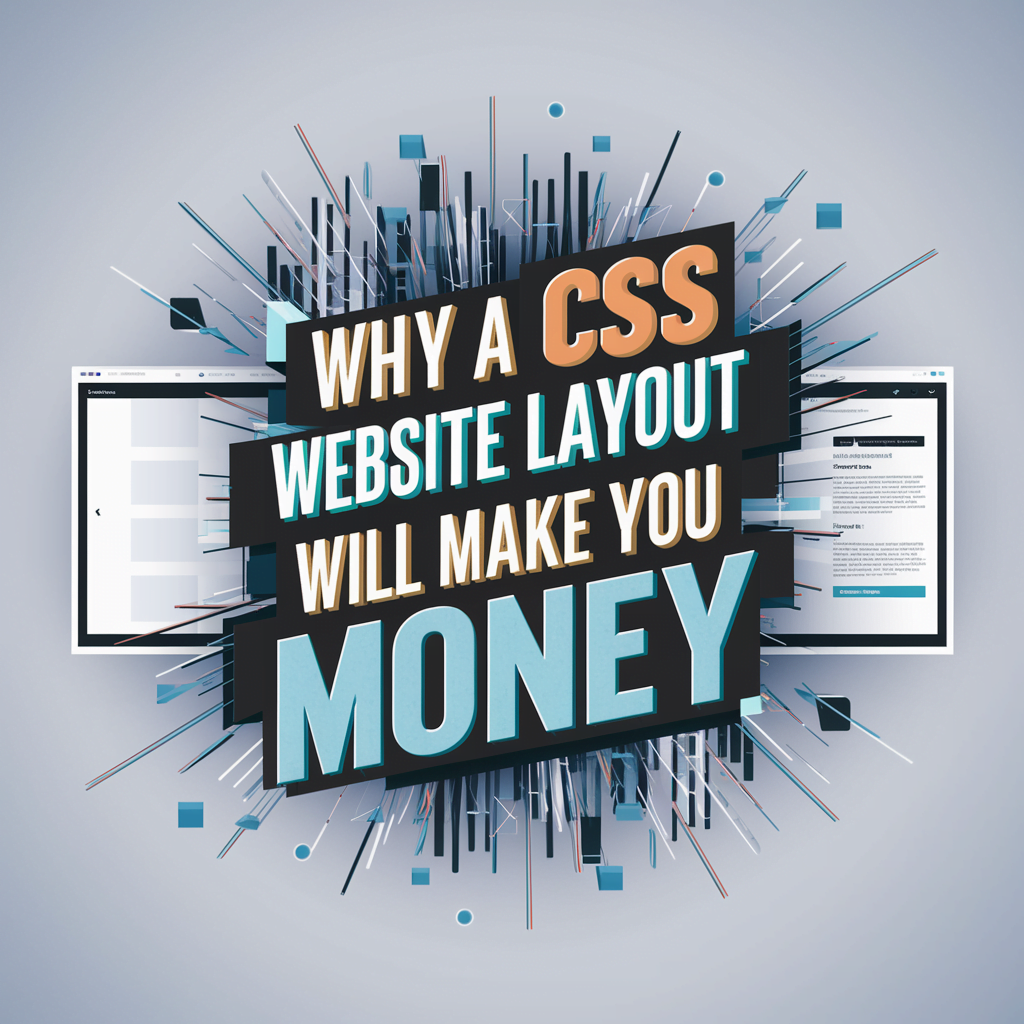Table of Contents
Introduction: CSS Website Layout Will Make You Money
In the digital age, your website is often the first point of contact between your business and potential customers. Cascading Style Sheets (CSS) play a crucial role in shaping this digital storefront, defining not just how your website looks, but how it functions and feels to users. But CSS is more than just a design tool—it’s a powerful asset that can directly impact your bottom line.
In this comprehensive guide, we’ll explore how a well-crafted CSS website layout can boost your profitability, enhance user experience, and give you a competitive edge in the digital marketplace.
The Power of First Impressions
Impact of visual appeal on user engagement
In the digital world, first impressions are formed in the blink of an eye. Research shows that users form an opinion about a website in as little as 50 milliseconds. This snap judgment is primarily based on visual appeal, which is where CSS shines.
Fact:
A study by Google found that users prefer websites with low visual complexity and high prototypicality (how representative a design looks for a certain category of websites).
How CSS enhances website aesthetics
CSS allows for precise control over colors, typography, spacing, and layout. This level of control enables designers to create visually stunning and cohesive websites that capture and retain user attention. By using CSS to create a visually appealing layout, you’re more likely to keep visitors on your site longer, increasing the chances of conversion.
Insight:
Websites with a strong visual hierarchy, created through strategic use of CSS, can guide users’ attention to key elements like call-to-action buttons, potentially increasing click-through rates by up to 20%.
Improved User Experience Leads to Higher Conversions
CSS techniques for intuitive navigation
A well-structured CSS layout can significantly enhance navigation, making it intuitive for users to find what they’re looking for. Techniques like consistent styling for interactive elements, clear visual hierarchies, and responsive menus all contribute to a smoother user journey.
Tip:
Use CSS to create hover effects on navigation elements. This provides immediate visual feedback to users, enhancing the interactive feel of your site.
Creating responsive designs for all devices
With mobile devices accounting for over 50% of web traffic worldwide, having a responsive design is no longer optional—it’s essential. CSS media queries and flexible grid systems allow for responsive designs that adapt seamlessly to various screen sizes, ensuring a consistent user experience across devices.
Fact:
According to Google, 61% of users are unlikely to return to a mobile site they had trouble accessing, and 40% visit a competitor’s site instead.
Faster Loading Times Increase Revenue
CSS optimization for improved page speed
Page speed is a critical factor in both user experience and search engine rankings. CSS can be optimized to reduce file sizes and improve loading times through techniques like minification, compression, and efficient selectors.
Insight:
A study by Akamai found that a 100-millisecond delay in website load time can hurt conversion rates by 7%.
Correlation between site speed and conversion rates
Faster websites not only provide a better user experience but also tend to have higher conversion rates. By using CSS to create lightweight, efficient layouts, you can significantly improve your site’s performance and, consequently, your conversion rates.
Tip:
Use CSS sprites to combine multiple images into a single file, reducing HTTP requests and improving load times.
Search Engine Optimization Benefits
How CSS contributes to better SEO rankings
While CSS doesn’t directly impact SEO, it plays a crucial role in several factors that search engines consider. These include page load speed, mobile-friendliness, and user experience metrics like time on site and bounce rate.
Fact:
Google has confirmed that page experience signals, including mobile-friendliness and page speed (both heavily influenced by CSS), are ranking factors in their search algorithm.
Structured layouts and their impact on crawlability
A well-structured CSS layout can improve the crawlability of your site by clearly defining the hierarchy of content. This makes it easier for search engines to understand and index your content, potentially leading to better search rankings.
Brand Consistency Across Platforms
Using CSS to maintain visual identity
Consistent branding across all platforms and devices is crucial for building brand recognition and trust. CSS allows you to define and maintain consistent colors, typography, and design elements across your entire website.
Insight:
Consistent branding across all platforms can increase revenue by up to 23%, according to a study by Lucidpress.
Building trust through consistent user experiences
A consistent user experience, facilitated by well-implemented CSS, helps build trust with your audience. When users have a seamless experience across different pages and devices, they’re more likely to feel confident in your brand and make purchases.
Cost-Effective Design and Maintenance
Reducing development time with CSS frameworks
CSS frameworks like Bootstrap or Tailwind CSS can significantly reduce development time and costs. These frameworks provide pre-built components and responsive grid systems, allowing for rapid prototyping and development.
Tip:
While using a CSS framework, customize it to fit your brand to avoid looking like every other website built with the same framework.
Ease of updates and modifications
With a well-structured CSS file, making site-wide changes becomes a breeze. Instead of updating each page individually, you can make changes to your CSS file that will be reflected across your entire site, saving time and reducing the chance of errors.
Mobile-First Approach and Its Financial Impact
CSS techniques for mobile optimization
A mobile-first approach, implemented through CSS, ensures that your site is optimized for the devices most of your users are likely using. This approach focuses on creating a great mobile experience first, then enhancing it for larger screens.
Fact:
Mobile e-commerce sales are projected to account for 72.9% of total e-commerce sales by 2021, according to Statista.
Tapping into the growing mobile commerce market
With a mobile-optimized site, you’re well-positioned to tap into the rapidly growing mobile commerce market. This can open up new revenue streams and help you reach customers who primarily shop on mobile devices.
Accessibility and Reaching a Wider Audience
CSS best practices for creating accessible websites
CSS plays a crucial role in creating accessible websites. Techniques like providing sufficient color contrast, scalable text, and focus indicators can make your site usable for people with various disabilities.
Insight:
The global market of people with disabilities is over 1 billion people with a spending power of more than $6 trillion, according to the World Bank.
Expanding your customer base through inclusive design
By using CSS to create an accessible website, you’re not just complying with legal requirements—you’re also expanding your potential customer base. An inclusive design can help you reach a wider audience and demonstrate your commitment to serving all customers.
A/B Testing and Continuous Improvement
Utilizing CSS for easy layout variations
CSS makes it easy to create variations of your layout for A/B testing. By simply changing your CSS, you can test different layouts, color schemes, or call-to-action placements to see what resonates best with your audience.
Tip:
Use CSS custom properties (variables) to easily swap out colors, fonts, or other styles in your A/B tests.
Data-driven design decisions to boost conversions
By combining CSS variations with analytics, you can make data-driven decisions about your website design. This iterative process of testing and improvement can lead to significant increases in conversion rates over time.
Future-Proofing Your Website with CSS
Emerging CSS technologies and their potential
CSS is constantly evolving, with new features like CSS Grid, Flexbox, and CSS Custom Properties offering more powerful and flexible ways to create layouts. Staying up-to-date with these technologies can give you a competitive edge and prepare your website for future developments.
Insight:
Adoption of modern CSS features like Flexbox and Grid can reduce development time by up to 50% for complex layouts, according to a survey of front-end developers.
Staying ahead of design trends for long-term success
By leveraging the latest CSS features, you can implement cutting-edge design trends more easily. This helps keep your website looking fresh and modern, which can be crucial for maintaining user engagement and conversions in the long term.
Conclusion
A well-implemented CSS website layout is far more than just a visual enhancement—it’s a powerful tool for driving profitability. By improving user experience, speeding up your site, enhancing SEO, providing consistency across platforms, and enabling data-driven design decisions, CSS can significantly impact your bottom line.
As we’ve explored, the benefits of effective CSS implementation range from increased user engagement to higher conversion rates and expanded market reach. By avoiding common pitfalls and staying abreast of emerging CSS technologies, you can ensure your website remains competitive and profitable in the ever-evolving digital landscape.
Now is the time to invest in your CSS strategy. Whether you’re building a new site or revamping an existing one, prioritizing a strong CSS foundation will set you up for long-term success and increased revenue. Remember, in the digital world, your website is your most important salesperson—make sure it’s dressed for success with CSS.
Frequently Asked Questions
Discover more from Style Exact
Subscribe to get the latest posts sent to your email.

